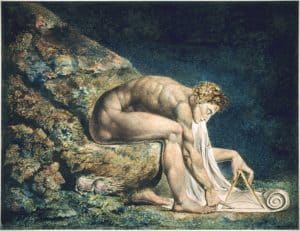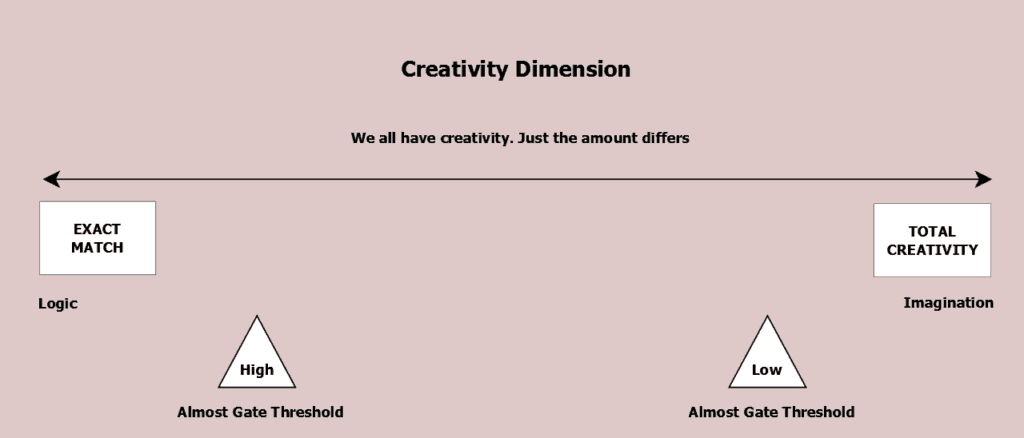New thoughts arises naturally from abstraction and induction arising from the neural threshold, its All-or-None response across the layers of cortical neurons.
Information, as it moves about our brain, loses some original specificity at each neural threshold. The assimilation of a current situation with recalled ones, on the other hand, can add features of the remembered situation to the abstraction sent to the next layer of neurons.
Matching of current to remembered is possible at many different levels of abstraction. If the level of abstraction is great, fewer original features need to match for the Almost Gate to be surmounted, which can lead us to considering consequences that wouldn’t be considered at more detailed (earlier abstraction) levels.
We use many words—intuition, rashness, imaginative, creativity, jumping to conclusions, a leap of faith, insight, impulsive, metaphor, going off half-cocked, and so on—in many contexts, attempting to capture aspects of novelty in thinking.
Novelty of thought is not restricted to Newton, Einstein, Picasso, and similar figures of towering intellectual and artistic creation (Figure 22.1). Novelty and creativity occurs in everyday life. It’s just that most of us apply our creativity to events of the daily life and in our personal sphere, unnoticed by all, except our friends and family. The difference is in the novel thought’s scope, not in its genesis.
Creativity
The Encyclopedia Britannica defines creativity as a new solution to a problem, a new method or device, or a new artistic object or form.Bringing something new is a task beyond deductive logic. Although logic can guarantee its conclusions, they are constrained to the content inherent in the premises. However, induction does bring something new when used to generalize from specific cases to a general theory. Counterbalancing induction’s power is the dangers of false associations.
Patterns are used in creative thinking.
In his “Essay on the Psychology of Invention in the Mathematics” (p14), Jacques Hadamard relays a Henri Poincare’s experience with inspiration, contrary to my custom, I drank black coffee and could not sleep. Ideas rose in crowds; I felt them collide until pairs interlocked, so to speak, making a stable combination.These thoughts are beyond logic. They follow from previously unrecognized similarities.
An especially apt quote from Colin Martindale’s “Biological Bases of Creativity.” (p 137) We have seen that the creative act involves the discovery of an analogy between two or more ideas previously thought to be unrelated. The discovery does not result from logical processing but, rather, emerges as a sudden insight.Induction is usually mundane. A slight generalization that resolves a piece of missing information in the puzzle of life, but sometimes, it’s larger. Ideas unexpectedly interlocking or a fresh analogy arising with sudden insight. A gross explanation consists of two parts. Creators have a low threshold on their Almost Gate and they apply themselves to situations which have not already be successfully solved.
Mechanism of Creativity
Searching through the literature for explanations of the actual act of creativity, phrases like flow or the Aha! of insight, are used to name the phenomenon. Mental Construction posits four operations that lead to creative thought.
1. Almost Gate
Neurons in the brain transfer their input forward if it surmounts the Almost Gate, i.e., if the sum of their input exceeds the neuron’s threshold. It doesn’t matter which of the (on average) 10,000 inputs are on, just that the aggregate is greater than the threshold. This means that raw data is eliminated from the information that flows out of the axon. It is an abstraction, a generalization with less detail, allowing substitutions of analogous entries from its category.
Sense data gets routed to specific parts of the brain to be enhanced. Similar data is seen repeatedly. Hebb’s Law of Neural Learning explains that the similar firing of sets of neurons induces them to fire again on similar sets of inputs. The pattern, the similar set of inputs, surmounts the Almost Gate, passing forward. Sensory and meaning (semantic) maps in our brains are learned, organized relationships, largely fixed when the critical period has ended for its brain location. Henceforth, the maps are used to arrange future situations into a personal categorical hierarchy.
After sensory data goes through the preliminary processing—extraction, abstraction, categorization—an interactive process with one’s memory, knowledge, and personal needs, wants, and fears occurs. With each step away from raw data, the sensory data becomes less distinct as well as encrusted with personal point-of-view values.
Since 99.9% of all cortex neurons receiving their input data from other cortical neurons, only 0.1% connect with the outside world (i.e., with sensory cells or motor cells). Each passing of a pattern in the next inward step increases imprecision upon the transfer of signal. If there is 99% fidelity in pattern transmission from one step to the next, after 50 processing steps (a low estimate in the number of handoffs of information) the match reduces to 60.5%. In Mental Construction concepts, the amount of external reality that is passed to deeper Almost Gates decreases at each step, implying that the Almost Gate input becomes increasing affected by memory relative to sensory input.
Creativity Dimension
As previously discussed, the Almost Gate is an idiosyncratic threshold. Depending on genetic factors, a person’s threshold is a particular height within the species range (78-85 mV above resting potential). Each person’s Almost Gate sends its signal downstream with a particular fidelity, which depends on the magnitude of the threshold. Although all people have Almost Gates, the different heights result in tighter or looser fits into categories.
At the left pole of the creativity dimension (Figure 22.2), people have very high Almost Gates. They require almost everything to be aligned before they will place their input into a category (declare a match). On the far right, people with quite low Almost Gates allow more sway in their categorization. They can place items into the same category, even when there are marked differences between things. More broadly, input to Almost Gates can be delivered from senses, processed patterns, words, categories, concepts, memories, and theories.
Caveat: This is Induction, not Deduction.
Induction is the mechanism for novelty. The neural composition of the brain makes induction the brain’s primary mechanism. Deduction arises from a specialized set of inductive modules that support words and logical operations. These modules exist only in the upper reaches of the dominant cortical hemisphere, where language originates and is processed.
Creativity Examples. True, Misleading
Creativity successes in science are well known.
- Einstein, imagining riding on a light wave in a thought experiment, leading to special relativity
- Newton, seeing an apple fall from a tree, thinking a similar force could be acting across space to pull on the Moon
- Dirac, considering the equations of atomic particles with their dual solutions, hypothesizing the existence of anti-particles
However, let’s consider minor but also more prevalent examples of novelty from daily life.
- We rarely describe the entire scenario when we want to convey it to another. We compare it against a similar circumstance that we expect the other person to know – and hopefully draw the same similarities.
- We use metaphors. Most created by others, but we’ve experienced their usefulness, so we employ those creative comparisons as if they were our own.
- When we pay attention to the news, we compare things to other understandings we have. It takes a creative leap to see how they can be fitted together.
- There is no overarching theory of the world that explains and connects all that everyone accepts.
- It is our creative effort, the novelty in our thoughts, which helps us knit everything together.
But creativity, and the similarities it suggests to us, can go far afield. I laugh every time I think of the universal translator. Not at it, but at the creativity is exposes in the metaphorical transformations of the English aphorism: The spirit is willing, but the flesh is weak. It’s translated to Russian then reversed back into English, where it’s rendered as The vodka is strong, but the meat is rotten.
Figure 22.3 shows, with sharp wit, how associated meanings of abstractions can seep as the thought travels in a mind.
- Spirit is an aspect of a being. Spirit is also a term for fermented drink. Vodka is a drink.
- Willing is a positive quality of a being. Good is a positive evaluation of an item.
- Flesh is the physical aspect of an animal. Meat is the term for an object that can be eaten.
- Weak is a poor manner of living. Rotten is a poor characterization of an object.
Each similarity makes sense by itself, but the overall meaning is drastically changed. How can we check against such mistaken conclusions? By checking external reality and by using logic.
The premises for logic—the facts we start with—originate in sensory information. Sensory data is abstracted, smoothed, organized, and valued according to inherently inductive processes. There is a significant conventional aspect to “facts” and yet they are the firmest of our mental propositions. Other propositions are facts told to us by others, explanations which link together facts, and predictions will use facts and explanations.
But induction and deduction don’t fight each other. They work together in the mental construction model, supporting different urgencies.
Other
Creativity Examples in Science Mendeleev, Kepler, Dirac
The Many Faces of Induction: From generalization to creativity


